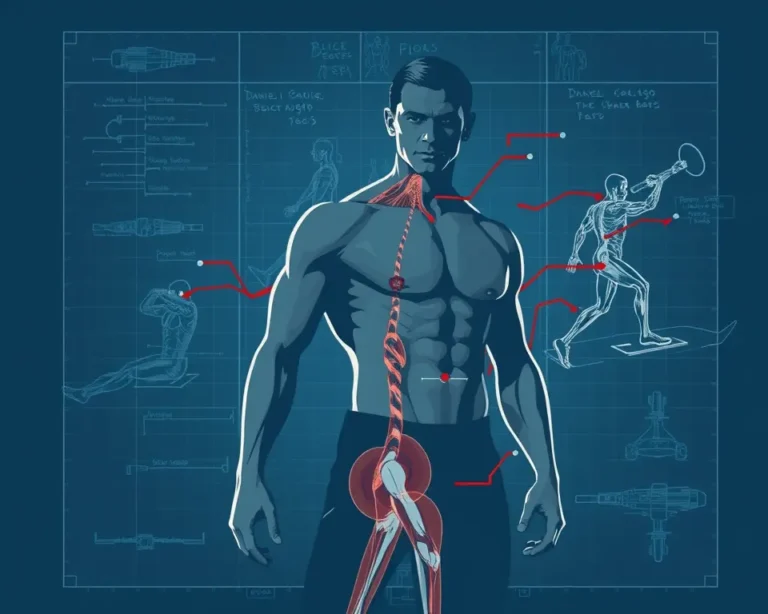For over a decade, Daniel Craig redefined James Bond, bringing a raw physicality and intensity never before seen in the iconic role. His transformation wasn’t just acting; it was a complete overhaul of his physical presence, turning him into a believable, formidable secret agent. So, how did he do it? The answer lies in a meticulously crafted fitness and nutrition regime, designed to build strength, agility, and the lean physique of a world-class spy.
The Mission: Building a Believable Bond
Craig’s approach to Bond’s physicality was revolutionary. He wasn’t aiming for bulky muscles, but rather functional strength and athleticism. “When Bond takes his shirt off, it should look like he could kill someone, not that he’s been out in the pub for the last two months!” Craig said, emphasizing the need for a physique that reflected the character’s deadly profession.
Enter Simon Waterson: The Man Behind the Muscle
The architect of Craig’s transformation is Simon Waterson, a former Royal Marine and elite special forces operative turned personal trainer. Waterson has been training James Bond actors since 1999, starting with Pierce Brosnan on The World Is Not Enough. However, he recognized a shift in approach with Craig. “Daniel came in and raised the bar with his athleticism,” Waterson noted. “He wanted to do his own stunts, it had to be him to make it feel real. It was a different era and mentality.”
Waterson’s military background proved invaluable, instilling discipline and structure into Craig’s training. He understood the importance of a comprehensive plan that addressed not only strength but also agility, endurance, and recovery.
The 007 Workout Blueprint
Craig’s workout routines varied depending on the specific demands of each film, but some core principles remained constant.
- Functional Training: The focus was on exercises that translated to real-world movements and stunt work. This meant prioritizing compound exercises that worked multiple muscle groups simultaneously.
- Consistency: Training was a year-round commitment, not just a pre-movie quick fix. Waterson started working with Craig a year before filming for No Time to Die began, and maintained the routine even during filming.
- Variety: Workouts incorporated a mix of strength training, cardio, and flexibility exercises to ensure well-rounded fitness.
- Recovery: Recognizing the demands of the role and Craig’s age, Waterson emphasized the importance of rest and recovery to prevent injuries and optimize performance.
A Typical Week in the Life of a Superspy
While the exact workouts evolved over time, here’s a glimpse into a sample weekly routine:
Strength Training: Building the Foundation
Craig typically trained 3-4 times a week, focusing on heavy weightlifting to build a solid base of strength.
A sample chest and triceps workout might include:
- Incline Barbell Bench Press: 4 sets x 6-10 reps
- Flat Barbell Bench Press: 3 sets x 6-10 reps
- Low Incline Dumbbell Flyes: 4 sets – 12, 10, 8, 6 reps
- Skull Crushers: 3 sets x 6-10 reps
- Rope Extensions: 2 sets x 8-12 reps
Full-Body Power Circuit: License to Thrill
This high-intensity circuit, performed once or twice a week, challenged Craig’s strength, endurance, and cardiovascular fitness.
A sample circuit includes 3 rounds of 10 reps each of the following exercises:
- Clean and Press
- Weighted Knee
- Weighted Step-ups
- Pull-ups
- Incline Push-ups
- Tricep Dips
Cardio: Outrunning the Bad Guys
To maintain his lean physique and build stamina, Craig incorporated cardio sessions twice a week. These included:
- Interval Sprints: Short bursts of high-intensity running alternated with periods of rest or low-intensity jogging.
- Steady-State Runs: Longer runs at a moderate pace to improve cardiovascular endurance.
- Agility Work: Agility ladder drills, cone drills, and other exercises to improve footwork, coordination, and reaction time.
The “No Time to Die” Daily Drill
For No Time to Die, Craig’s daily routine was particularly grueling:
- 5:30 AM: Wake up and commute to Pinewood Studios.
- 7:00 AM: Pre-shoot physical preparation with Waterson, including muscle activation and stretching.
- 8:00 AM: Energy-filled, anti-inflammatory breakfast.
- 9:00 AM – 7:00 PM: Filming, with action sequences interspersed with dialogue. Waterson provided recovery work (stretching, percussive tools) during breaks.
- 7:45 PM: Carb-heavy dinner and debrief.
Key Exercises Highlighted by Waterson
Waterson emphasizes a few key exercises for overall strength and conditioning:
- Barbell Deadlift: For full-body recruitment and power.
- Pull-ups: For upper body strength and back development.
- Squats: A compound exercise that works multiple muscle groups, building lower body strength and power.
Sample “No Time to Die” Warm-up
Before intense workouts or filming, Craig would perform this warm-up routine:
- Muscle Activation and Stretching
- Assisted Pull-Ups: 2 sets of 25 reps
- Agility Ladder Exercises: 2 sets of 60 seconds
- Bosu Mountain Climbers: 2 sets of 25 reps
- Bike and Running Sprints: 2 sets of 60 seconds
Fueling the Spy: The 007 Diet
Craig’s diet was as crucial as his workouts. He focused on providing his body with the nutrients it needed to recover from intense training and perform at its best.
The Core Principles:
- Lean Protein: Essential for muscle building and repair. Sources included chicken, fish, eggs, and lean red meat.
- Complex Carbohydrates: Providing sustained energy for workouts and daily activities. Examples include brown rice, quinoa, and vegetables.
- Healthy Fats: Important for hormone production, brain function, and overall health. Sources included avocados, nuts, seeds, and olive oil.
- Frequent Meals: Craig ate 5-6 small meals throughout the day to keep his metabolism revved up and provide a constant supply of nutrients.
- Limited Alcohol: While Bond is known for his martinis, Craig limited his alcohol intake to two nights per week.
- No Junk Food: Processed foods, sugary drinks, and unhealthy fats were strictly avoided.
A Sample Daily Meal Plan:
- Breakfast: Poached eggs with two slices of toast.
- Snack 1: Protein shake with nuts and probiotics.
- Lunch: Fish, white meat, vegetarian, or red meat, with a focus on plant-based meals.
- Snack 2: Another protein-rich snack, such as Greek yogurt or a handful of almonds.
- Dinner: Carb-heavy meal for recovery after filming.
The Importance of Recovery Nutrition
Waterson emphasized the importance of post-workout nutrition for Craig’s recovery. After workouts, Craig would refuel with a plant-based recovery shake containing nut milk, protein, and greens. He also took a shot of turmeric root juice, a natural anti-inflammatory, and a probiotic shot to boost immunity.
Beyond the Physical: The Mental Fortitude of 007
While the workouts and diet played a significant role in Craig’s transformation, it’s important to acknowledge the mental fortitude required to sustain such a demanding lifestyle. He approached the role with a dedication and discipline that few actors possess.
“He has evolved the character physically and mentally, which was a decision he made from day one,” Waterson said. “He wanted to become faster and more efficient throughout so it became more about the athleticism rather than aesthetics.”
The Legacy: A New Standard for Action Heroes
Daniel Craig’s portrayal of James Bond raised the bar for action heroes. He demonstrated that it’s not enough to simply look the part; you have to embody the physicality and athleticism of the character. His transformation inspired countless individuals to prioritize their fitness and embrace a more active lifestyle.
While replicating Craig’s exact routine may not be feasible for everyone, the core principles – functional training, consistent effort, a balanced diet, and a focus on recovery – can be applied to any fitness journey. By embracing these principles, you can unlock your own inner 007 and achieve a level of fitness you never thought possible.







